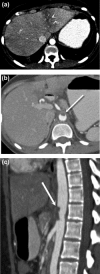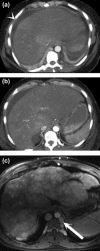Imaging features of hepatic arterial and venous flow abnormalities
- PMID: 30992783
- PMCID: PMC6385935
- DOI: 10.1002/cld.686
Imaging features of hepatic arterial and venous flow abnormalities
Figures






Similar articles
-
Hemodynamics of experimental portal venous occlusion in dogs.Am Surg. 1975 Apr;41(4):198-202. Am Surg. 1975. PMID: 1122071
-
Hepatic arterial and portal venous flows during hemorrhage.Eur Surg Res. 1975;7(4-5):259-68. doi: 10.1159/000127811. Eur Surg Res. 1975. PMID: 1181189
-
Role of the hepatic artery in the metabolism of phenacetin and acetaminophen: intravital microscopic and multiple-indicator dilution study in perfused rat liver.Hepatology. 1994 Sep;20(3):672-83. Hepatology. 1994. PMID: 8076925
-
Simultaneous measurement of hepatic arterial and portal venous flows by transit time ultrasonic volume flowmetry.Surg Gynecol Obstet. 1988 Jul;167(1):65-9. Surg Gynecol Obstet. 1988. PMID: 2968000
-
Improved diagnosis of hepatic perfusion disorders: value of hepatic arterial phase imaging during helical CT.Radiographics. 2001 Jan-Feb;21(1):65-81; questionnaire 288-94. doi: 10.1148/radiographics.21.1.g01ja0165. Radiographics. 2001. PMID: 11158645 Review.
Cited by
-
Wandering intravascular air gun BB pellet.Radiol Case Rep. 2020 Oct 12;15(12):2627-2631. doi: 10.1016/j.radcr.2020.09.055. eCollection 2020 Dec. Radiol Case Rep. 2020. PMID: 33088376 Free PMC article.
-
Lessons of the month: Acute liver failure: a case close to the heart.Clin Med (Lond). 2021 Mar;21(2):e234-e236. doi: 10.7861/clinmed.2020-1062. Clin Med (Lond). 2021. PMID: 33762393 Free PMC article.
-
Correlation between portal vein diameter and craniocaudal length of the spleen.J Ultrason. 2019 Dec;19(79):276-281. doi: 10.15557/JoU.2019.0041. Epub 2019 Dec 31. J Ultrason. 2019. PMID: 32021709 Free PMC article.
-
Risk Factors for In-hospital Mortality After Transarterial Intervention After Postpancreatectomy Hemorrhage.Cardiovasc Intervent Radiol. 2020 Sep;43(9):1342-1352. doi: 10.1007/s00270-020-02509-2. Epub 2020 May 20. Cardiovasc Intervent Radiol. 2020. PMID: 32435837 Free PMC article.
-
Eosinophilic Pneumonia Induced by Daptomycin.Cureus. 2024 Feb 27;16(2):e55095. doi: 10.7759/cureus.55095. eCollection 2024 Feb. Cureus. 2024. PMID: 38558746 Free PMC article.
References
-
- Ryan MF, Hamilton PA, Sarrazin J, Chu P, Benjaminov O, Lam K. The halo sign and peripancreatic fluid: useful CT signs of hypovolaemic shock complex in adults. Clin Radiol 2005;60:599‐607. - PubMed
-
- Lubner M, Demertzis J, Lee JY, Appleton CM, Bhalla S, Menias CO. CT evaluation of shock viscera: a pictorial review. Emerg Radiol 2008;15:1‐11. - PubMed
-
- Oderich G, Panneton JM, Bower TC, Ricotta JJ 2nd, Sundt TM 3rd, Cha S, Gloviczki P. Aortic dissection with aortic side branch compromise: impact of malperfusion on patient outcome. Perspect Vasc Surg Endovasc Ther 2008;20:190‐200. - PubMed
-
- Holbert B, Baron RL, Dodd GD 3rd. Hepatic infarction caused by arterial insufficiency. AJR Am J Roentgenol 1996;166:815‐820. - PubMed
-
- Raab BW. The thread and streak sign. Radiology 2005;236:284‐285. - PubMed
Publication types
LinkOut - more resources
Full Text Sources

